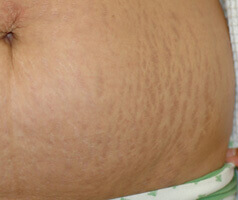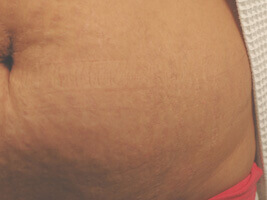There’s no denying that stretch marks can be frustrating. Whether you’re male or female, young or older, if you have them, you probably wish you didn’t. They can appear after pregnancy, muscle gain, rapid weight changes, or even normal adolescent growth.
Why Stretch Marks Happen
Stretch marks occur when the skin stretches faster than it can keep up. The collagen and elastin fibers that support the skin’s structure tear under pressure, leaving behind visible marks. While the exact reason some people develop stretch marks and others don’t isn’t fully understood, genetics plays a major role. If your parents or close relatives have them, chances are you will too—regardless of the preventive steps you take.


How Stretch Marks Look
Not all stretch marks look the same.
- Color: They can appear red, purple, brown, or white depending on your skin tone and how long you’ve had them.
- Texture: Some are flat, while others look indented or slightly raised.
Fresh stretch marks tend to be red or purplish, especially on lighter skin tones. On darker skin, they may look brown or darker than the surrounding area. Older stretch marks fade over time and often turn white or silvery, which makes them harder to treat.
Common Questions About Stretch Marks
Why Do Some People Get Stretch Marks While Others Don’t?
It comes down to genetics. Just like eye or hair color, stretch mark susceptibility can vary from one person to another—even within the same family.
Are Stretch Marks Permanent?
Technically, yes. Stretch marks are a type of scar. However, laser treatments can help reduce their visibility by improving color and texture, making them much less noticeable.
Do Creams or Lotions Work?
Despite what many brands claim, no cream or lotion can completely prevent or remove stretch marks. Some may temporarily plump the skin, but once you stop using them, the effect fades. If you’re genetically predisposed, stretch marks may appear regardless of what you apply.
Why Do Stretch Marks Vary in Color?
The color depends on skin type and the age of the stretch mark.
- Red or Purple: New marks with active blood vessels.
- Brown: Common on darker skin tones.
- White or Silvery: Older marks that have lost pigment and are tougher to treat.
Laser Treatment for Stretch Marks
Which Lasers Work Best?
Different lasers target different types of stretch marks:
- Pulsed Dye Laser: Treats red stretch marks by targeting blood vessels.
- Q-Switched Laser: Fades dark brown marks by breaking down excess pigment.
- Aramis Quantel Laser: Uses heat to stimulate collagen, improving the texture of older or white stretch marks that don’t have pigment for the laser to “see.”
At Celibre Medical, we often combine these lasers to achieve the best outcome. This multi-laser approach allows us to address both color and texture without aggressive recovery time.
How Does Celibre Medical Customize Treatments?
Our nurses use a tailored approach, adjusting settings and combinations based on your skin type and stretch mark condition. While some clinics use more aggressive fractionated or plasma lasers, we find our combination therapy delivers similar results with less downtime and lower cost.
What to Expect from Laser Treatments
Realistic Results Matter
We believe in setting honest expectations. Stretch marks won’t disappear completely, but you can expect a noticeable improvement in texture and color. Any clinic promising total removal is being unrealistic—if it sounds too good to be true, it usually is.
Candidacy and Treatment Details
Can All Skin Types Be Treated?
Yes. The lasers we use are safe for all skin tones and types. Treatments have no downtime, so you can return to normal activities right after your session.
How Long Does Each Session Take?
It depends on the treatment area. Small areas may take 15–20 minutes, while larger or multiple areas may take up to an hour.
Who Should Avoid Laser Treatments?
We recommend against treatment for:
- Anyone with unrealistic expectations.
- Those still experiencing growth or weight changes.
- Patients who would benefit more from surgical options, like a tummy tuck.
When Is Surgery a Better Option?
If you have significant loose skin, a tummy tuck might be more effective. However, if your stretch marks extend above your belly button, even surgery may not remove them completely. Most patients can expect 50–60% removal through surgery.
Timing Your Laser Treatment
The sooner you treat stretch marks, the better the results. Early treatment can interrupt inflammation, help rebuild collagen, and improve the skin’s ability to repair itself. Over time, this leads to smoother, more even skin with less noticeable marks.
Stretch marks are common and completely normal. While they may not disappear entirely, laser treatment can make a real difference in how they look and feel—helping you feel more confident in your skin.

